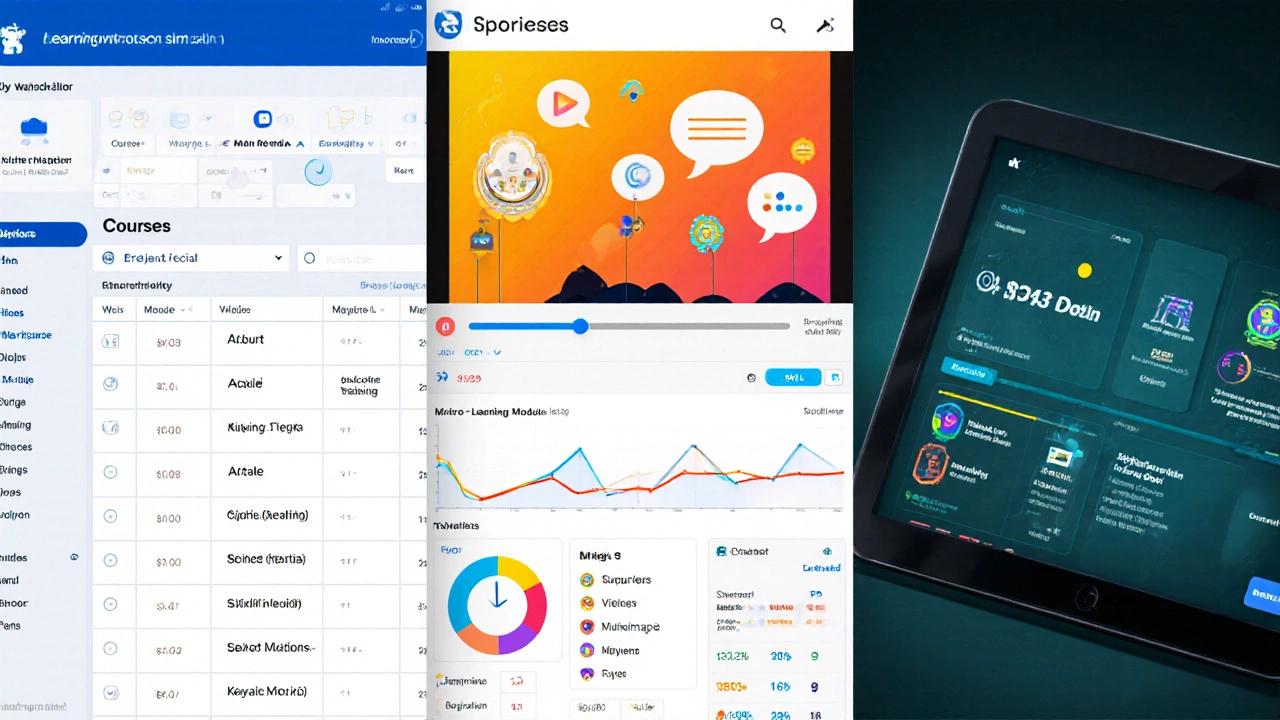Learning Management Systems, or LMS, have become an integral part of today's education landscape, revolutionizing how courses are delivered and managed. As technology advances, so does the sophistication of these systems, making them indispensable tools for educators and learners alike.
Beyond just organizing course content, LMS platforms offer interactive features that enhance learning and development. They serve not only educational institutions but also businesses looking to upskill their workforce.
In this article, we'll delve into what LMS stands for, explore its various features, examine the different types available, and provide insights into choosing the right platform to suit your educational or training needs.
- Defining LMS
- Key Features of LMS
- Types of LMS Platforms
- Benefits for Educators and Learners
- Trends in LMS Technology
- Selecting the Right LMS for Your Needs
Defining LMS
The term LMS stands for Learning Management System, a powerful tool commonly used in both educational and corporate environments. At its core, an LMS is software that provides a framework to manage, deliver, and track educational courses or training programs. Its primary purpose is to simplify the process of creating and conducting learning programs online. The roots of modern learning management systems can be traced back to the early digitalized education formats, which were rudimentary compared to today's technologically advanced systems.
One might wonder how an LMS differs from just any educational website or online resource. The answer lies in its comprehensive functionality—an LMS is not merely a static library of courses. It is an interactive platform that integrates various learning tools to foster a more engaging and effective educational experience for users globally. These platforms support different types of content including videos, quizzes, and live discussions, all of which can be accessed by learners at their own pace, making LMS tools particularly valuable in today's fast-paced world. The range of users who benefit from LMS platforms is vast, encompassing K-12 students, university learners, and professionals across diverse industries.
According to a recent study, around 80% of higher education institutions in the United States leverage some form of LMS technology. This statistic underscores the critical role that these systems play in contemporary education. Moreover, businesses are rapidly adopting LMS platforms to facilitate staff training and development. This shift speaks to the adaptive nature of LMS, which can be customized to meet the specific needs of different domains.
"An LMS is more than just a tool; it's a gateway to achieving learning goals and nurturing talent across the globe," said EdTech expert Dr. Linda Reeves in her comprehensive review of digital learning technologies.
The architecture of an LMS typically includes various subsystems that handle registration, course administration, learner management, and user interactions. Modern LMS platforms often provide detailed analytics and reporting tools that help educators and trainers monitor progress and optimize learning pathways. E-learning features such as gamification, mobile learning capabilities, and social collaboration are increasingly becoming standard, driven by user demand for a more dynamic and engaging learning process. Some LMS platforms even incorporate artificial intelligence to offer personalized learning experiences, adapting content based on an individual's progress and learning style.
For those exploring LMS options, understanding the key elements that define these systems is crucial. Among the most important considerations are user-friendliness, compatibility with existing technologies, and the flexibility to integrate with other tools and apps. An effective LMS must be scalable to accommodate varying numbers of learners, from small groups to thousands of users simultaneously. Additionally, strong security measures are a non-negotiable aspect of LMS design, ensuring that access to course materials and sensitive user data is protected against breaches.
In conclusion, a robust LMS does much more than facilitate the distribution of learning content. It empowers educators and trainers to create truly interactive learning environments and provides learners with the tools they need to thrive in today's knowledge-driven world.
Key Features of LMS
In the realm of online education, Learning Management Systems (LMS) shine as the central hub for delivering, tracking, and managing educational content. These systems are engineered to offer a seamless experience for both educators and learners, packed with a plethora of features aimed at enhancing educational delivery. At the core, an LMS provides a centralized location for course documentation, grading, and feedback, effectively eliminating the chaos associated with managing educational content across multiple platforms. The ability to integrate multimedia elements such as videos, podcasts, and interactive quizzes transform traditional learning into a more engaging and interactive experience.
The integration capabilities of an LMS cannot be understated. Most platforms allow integration with existing tools and applications, such as Google Workspace or Microsoft Office, allowing for a smooth transition and minimal disruption. Unlike traditional classroom setups, an LMS provides 24/7 access to course materials, fostering asynchronous learning which is essential in today’s fast-paced world. This flexibility caters to different learning styles and schedules, ensuring that each learner can interact with the content in a manner that best suits them. Additionally, the built-in analytics tools deliver insights into student progress and engagement, enabling educators to tailor their teaching methods to better serve their students' needs.
Quiz and assignment management features are another standout aspect of any robust LMS. These systems automate grading processes, freeing up valuable instructor time and allowing them to focus on more meaningful interactions with students. With adapted learning paths, an LMS can modify the content delivery based on an individual's performance, ensuring students achieve mastery before advancing. Training platforms help not only in academic settings but also in corporate environments, automating much of the bureaucracy involved in professional development. A well-designed LMS is built not only to track learning outcomes but also to support ongoing development through certification and credit management features.
Engagement is significantly enhanced through collaboration features available in many LMS platforms. Tools such as forums, private messaging, and real-time chat facilitate the development of vibrant learning communities where students can engage with their peers, share resources, and clarify doubts with tutors. An integrated calendar helps students and trainers stay informed about upcoming deadlines and events. A notable quote from Dr. Jane Hart, an influential voice in the e-learning space, states,
"A well-implemented LMS integrates seamlessly into an institution's learning ecosystem, creating a dynamic and fluid environment for personal and collective growth."The effectiveness of an LMS is truly highlighted when it becomes a natural extension of the learning and teaching experience, enhancing outcomes through strategic planning and implementation.

Types of LMS Platforms
When we dive into the world of Learning Management Systems, we see a vibrant tapestry woven from various platform types, each catering to distinct educational or corporate environments. Broadly speaking, these platforms can be divided into three main categories: open-source LMS, commercial LMS, and cloud-based LMS. Each type comes with its unique set of advantages and challenges, making it essential to understand their differences.
Open-source LMS platforms are like a canvas for tech-savvy organizations that relish the flexibility of customizing their systems. These platforms provide the basic framework, allowing users to tweak and expand functionalities to match their specific needs. A popular choice in this category is Moodle, recognized for its adaptability and robust community support. However, with great power comes great responsibility, as the onus of maintenance, updates, and security rests with the user. For those with the resources and expertise to manage it, open-source LMS platforms offer unprecedented flexibility, but this can be daunting for smaller organizations with limited technical skills.
Commercial LMS platforms, on the other hand, are developed and managed by companies specializing in e-learning solutions. Platforms like Blackboard and Canvas fall under this umbrella. These platforms tend to have more user-friendly interfaces and come equipped with a team of developers ready to assist with troubleshooting and support. The investment in a commercial LMS can be substantial, but users often find the peace of mind provided by dedicated support and continuous updates worth the cost. It is these benefits that often lead educational institutions and large enterprises to favor commercial LMS solutions.
Another critical player in this landscape is the cloud-based LMS. These platforms offer the benefit of being hosted on the cloud, making them accessible from anywhere with an internet connection. Services such as Google Classroom and TalentLMS exemplify this type. The cloud model generally entails a subscription fee but relieves the user from the burdens of server maintenance and uptime considerations. For organizations prioritizing ease of use and quick deployment, cloud-based LMS platforms can be a fantastic choice. They provide scalability and feature regular updates seamlessly integrated into the platform without the need for tedious manual installations.
It's worth noting a trend in the industry where many platforms, regardless of type, now incorporate sophisticated analytics and reporting tools. This trend is driven by the increased reliance on data-driven decision-making in education and corporate training. By utilizing these tools, stakeholders can track learner progress, assess the effectiveness of courses, and tweak content to better suit their audiences.
According to a survey by Docebo, the global LMS market is expected to grow significantly, indicating a shift towards more digitally flexible learning solutions.
Learners are increasingly demanding education that fits into their lifestyles, and LMS platforms provide the infrastructure for this evolution," said John Stone, an education technology strategist.
When selecting an LMS, it's not just about choosing a reputable brand; it's about aligning the platform's capabilities with the organization's strategic goals and the learners' specific needs. Each type of LMS serves a different purpose, so understanding these differences will help decision-makers choose the right platform to unlock their institution's full potential in the digital learning space.
Benefits for Educators and Learners
In today's fast-paced world, the integration of LMS platforms in education and training environments offers a wide array of benefits for both educators and learners. For educators, the use of an LMS streamlines the administrative side of teaching, freeing up valuable time that can be spent on developing engaging course content. With automated grading systems, attendance tracking, and the ability to easily update and distribute teaching materials, LMS platforms significantly reduce the bureaucratic load that teachers traditionally face.
Not just a tool for reducing paperwork, LMS platforms also provide educators with innovative tools to enhance the teaching experience. Interactive features such as discussion forums, quizzes, and multimedia presentations allow for a more dynamic and interactive classroom, even in a digital space. This not only helps in maintaining student interest but also supports diverse learning styles. According to a study by the Educause Center for Analysis and Research, nearly 70% of teachers reported improved student engagement after integrating an LMS into their curriculum.
For learners, LMS platforms offer flexibility and accessibility that traditional classroom setups often cannot provide. Students can learn at their own pace, revisit materials anytime, and even participate in courses across the globe, removing geographic and temporal barriers to education. This means that anyone, whether a full-time student or a working professional, can expand their knowledge base without significantly disrupting their current life schedule. A notable example is the surge in enrollment for online courses since the COVID-19 pandemic, illustrating a shift towards remote learning environments enabled by efficient LMS.
Notably, the analytics and feedback features of an LMS provide learners insights into their own progress. This empowers students to take responsibility for their learning, identifying areas where they excel or need improvement. Importantly, real-time analytics from LMS platforms give both educators and learners a deeper understanding of student performance, facilitating timely interventions and supporting personalized learning trajectories.
"The use of LMS in modern learning environments transcends beyond mere digital classrooms; it paves the way for a holistic approach to education, fostering a culture of continuous learning and adaptability," says Dr. Carl Windsor, an educational technology specialist.
Incorporating technology is no longer a luxury but a necessity, and e-learning platforms offer a practical solution. As we continue to witness advances in LMS technology, the scope for enhanced educational experiences only expands, promising a future where learning is universally accessible and deeply personalized. This dynamic can forge a new generation of empowered, informed, and interconnected learners ready to meet the challenges of their various professional fields.

Trends in LMS Technology
As the digital era continues to flourish, LMS technology is constantly evolving to meet the needs of both educators and learners. A significant trend is the integration of artificial intelligence in LMS platforms. AI enhances the learning experience by offering personalized content suggestions, automating administrative tasks, and even assisting in grading assignments. With AI's predictive analytics, educators can identify students who might need additional help long before they reach out. This proactive approach helps improve student retention and success rates.
Another notable trend is the increasing adoption of mobile learning. With the proliferation of smartphones, LMS platforms have developed apps or mobile-friendly interfaces that allow learners to access course materials, submit assignments, and participate in discussions on the go. This flexibility is especially beneficial for adult learners and professionals who balance education with other responsibilities.
Gamification is also gaining traction. By incorporating elements like badges, leaderboards, and challenges into course design, LMS providers enhance student engagement and motivation. Gamification turns learning into an interactive and enjoyable experience, which boosts knowledge retention. Studies have shown that gamified learning environments can increase average retention by up to 30% compared to traditional methods.
Seamless integration capabilities are another emerging feature of modern LMSs. Educators can now link their systems with third-party tools such as Zoom, Google Workspace, and Microsoft Teams. This integration not only streamlines the teaching process but also enhances the learning experience by providing various tools within a single platform.
The trend towards immersive learning experiences is growing with the use of virtual and augmented reality tools in LMS technology. These technologies provide learners with realistic scenarios and environments that help in better understanding complex subjects. For instance, medical students can practice surgeries in a virtual operating room, while engineering students might simulate construction projects.
According to John Baker, CEO of D2L, "The future of learning lies in making it more personalized and accessible. LMS platforms are increasingly investing in technologies that enable this shift, giving every learner a chance to thrive."
Finally, sustainability and data privacy are becoming critical areas of focus. As digital platforms collect vast amounts of data, LMS providers are emphasizing eco-friendly practices and robust security measures to protect user information. This ensures a safe and responsible learning environment, which is particularly crucial as data breaches become more common.
Keeping up with these trends not only improves the educational experience but also prepares institutions and organizations to meet the ever-evolving demands of the education sector. By adopting these cutting-edge features, but makes full use of everything that modern technology has to offer. It's a testament to the innovation and adaptability inherent in the world of e-learning.
Selecting the Right LMS for Your Needs
Choosing the right LMS for your needs is like selecting the perfect recipe; it demands thought, understanding, and clarity of your specific ingredients. First, it's essential to recognize your institution's or organization's primary objectives with an LMS. Are you focusing on delivering structured education, corporate training, or perhaps a blend of both? Each type has unique functional necessities, which will define the nature of the LMS best suited for you. For educational setups, features like gradebooks, student-teacher communication tools, and plagiarism detection are vital. On the other hand, businesses might prioritize seamless integration with HR systems, robust reporting tools, and sophisticated analytics. The end goal should align with what the LMS can offer so that it genuinely meets your requirements.
Scalability is another crucial aspect to ponder upon. If you are a growing institution or business, the LMS must be able to evolve alongside you. How many users will it support? Does it accommodate a surge in user enrollment during peak seasons without compromising performance? Look for platforms that describe themselves as scalable, and thoroughly test this with trial versions if possible. This capability will ensure you won't find yourself outgrowing the system within a short timeframe, saving you time and resources in the future.
Delving into user experience is equally paramount. A visually appealing and user-friendly interface could greatly enhance both educator and learner satisfaction, reducing the training time needed to adapt to the system itself. A good LMS must intuitively cater to the needs of its users, offering features like easy navigation, accessibility for all students, and customizable dashboards. Numerous studies underscore that visually pleasing and well-organized platforms increase educational engagement by a significant 23% margin, an impressive statistic that shows the importance of user experience.
Budget Considerations
Budget can often dictate the choices you have at your disposal, but it doesn’t always mean you need to compromise on quality. There are numerous platforms offering diverse pricing structures, ranging from open-source options to high-end customizable systems. Open-source platforms allow vast customizability and usually involve lower initial costs, yet may require more technical expertise to set up and maintain. Conversely, premium systems might offer extensive customer support and features but at a steeper price. Calculating the total cost of ownership, including setup, maintenance, training, and potential scalability expenses, offers a clearer financial picture.
"Cost should not be the sole determinant of your LMS choice, but a tool working in harmony with your institution's growth philosophy," says Dr. Eliza Harrington, an expert in educational technologies.
Don’t forget the essence of trial periods and in-person demonstrations when selecting your e-learning platform. Many LMS providers offer free trials or demos. Utilize these opportunities to engage not just the IT team but also teachers and end-users, providing feedback based on actual use cases specific to your needs. This holistic feedback loop can illuminate strengths or weaknesses not visible in initial pitches or documentation, thus empowering you to make informed decisions. By taking a systematic and thoughtful approach, you can ensure the selected LMS will enhance and complement the learning journey you aim to facilitate.














